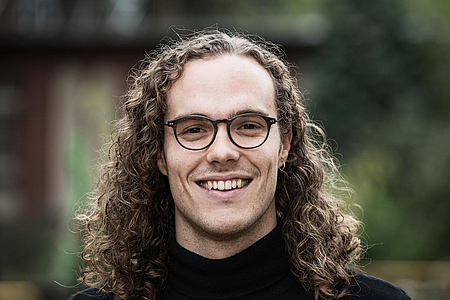When the aquarium starts making noises
Thomas Chaigne originally worked as a physicist in optics and acoustics, where he studied the scattering of light in turbid media such as biological tissue. However, as a postdoctoral researcher, he wanted to get a deeper insight into the applied research. At our meeting in Berlin, he described the surprises that awaited him there as a physicist and explained what fish brains have to do with acoustics.
Dr. Chaigne, two words stand out in your project description: “fish” and “hearing”. How do those go together, and how as a physicist did you end up studying this topic?
I knew Professor Judkewitz for his work about optical imaging in scattering media, a field in which I did my own PhD. As I wanted to go toward neurobiology for my postdoc, his laboratory was a very good match in terms of research interest and I therefore took the opportunity of getting into his laboratory through the Humboldt Research Fellowship funded by Stiftung Charité. At about the same time, his research team began to work with a new fish, Danionella translucida. This is a small fish which, unlike the more common model fish, the zebrafish, remains transparent even as a fully-grown adult. This unique feature allows us to image the activity of the entire brain while the animal is experiencing sensory stimulations or perfoming complex behavioral tasks. An additional peculiarity of this fish is its social vocalisation behaviour: one can hear clicking noises coming from the aquarium that could remind of cicadas. Studying hearing was then the next logical step, as this behaviour is likely to be associated with well-developed hearing capabilities.
You study fish, but your laboratory is located at the Charité. Can your research results be applied to human beings too?
Not in the near future. But the idea underlying our work is to ultimately be able to show an entire brain through the microscope. Once you have a better understanding of a fish’s brain, you can move on to the next level. That wouldn’t be the human being yet, but mice or other mammals. In the mouse, it is currently only possible to show a small portion of the brain at a very superficial level, as you can’t look deeper. However, researchers have been working on mapping out the entire brain of zebrafish larvae for several years now. We now want to try to do the same thing with adult fish. This does not bring direct gains regarding therapy, but the foundations are being laid for further important projects in this direction.
How are the images created?
To measure the brain activity, we get neurons to produce molecules with visual characteristics that change in the case of active cells. When neurons communicate, they send electrical signals. If you then acquire an image with the microscope, these cells emit flashes. Based on these pictures, it’s possible to discover which neurons are connected with one another and what kind of signals they send. To study the hearing mechanisms, we also have to measure the mechanical response of the various structures involved to sound. For this we do not need any labelling, and the image is built by measuring the reflected light from this bony or tissue structures.

Funding program
Humboldt Research Fellowships at BIH
Funding period
2018 – 2019
Project title
Biophysics and physiology of directional hearing in fish
Research area
Systems neurobiology
Institution
Charité – Universitätsmedizin Berlin
Since January 2019
Tenured research fellow (CNRS), Fresnel Institute, Marseille, France
2016 – 2018
Postdoctoral fellow, Judkewitz Lab, Neurocure, Charité University Hospital, Berlin, Germany
2012 – 2016
PhD candidate, Langevin Institute and Kastler-Brossel Laboratory, Paris, France
So are you studying the brain or the sense of hearing?
I’m studying how the fish can locate a sound source in space. Human beings perceive signals in the left and right ear with a slight delay and a difference in amplitude. However, a fish is much smaller and the wavelength of sound is significantly larger. Nevertheless, their behavior shows that the fish can locate the source of the sound. From an evolutionary viewpoint this is important if, for example, a predator is approaching. I observe which mechanical structures move due to the sound waves. The fish can perceive sounds in two ways. The first way is through special accumulations of calcium called “otoliths” or “earstones”. These are denser than the rest of the tissue and therefore move less when the sound wave hits them. The tissue bends the hair cells that connect it to the earstone.
Have you been surprised by anything else that you’d never have expected in Berlin or Germany?
I thought that the administration would run more efficiently here in Germany. In fact, it’s exactly the same as in France – slow and complicated. I also noticed that the people here automatically switch to English as soon as someone in the room doesn’t speak German. That would never happen in France, even if you’re taking part in a discussion. If you don’t say anything for a minute or so, the people immediately switch back to French. I find that impolite. At the same time, I sometimes wish that it was just like that here – then I’d have to speak German more often. At the moment I really only speak it during sports or at the supermarket. A good exercise in Thai boxing is to practice understanding someone who’s speaking through their mouthguard. At least I do know all the parts of the body in German.
Is this your first stay in Germany, or did you already have a connection with your neighboring country?
German was in fact my first foreign language, but I’d forgotten almost everything since my schooldays. In eighth grade, on a school exchange program in Germany, I was in a region on the Rhine where they grew wine. Later, during my university studies, I worked at the Forestry Office in Baden-Baden for one summer. Usually, we only had to cut the grass next to the path to the Forestry Office, which seemed to be very important there. We also pulled up weeds – i.e. basically all the tasks that they didn’t like doing themselves.
So do you prefer nature to the city?
I grew up in the country in Beaujolais and I often helped with the grape harvest there. That’s why Paris took some getting used to – but in the end, I liked it there too. After a couple of years in Paris, Berlin was the perfect compromise: the streets are wider, the apartments are bigger, and it isn’t as overcrowded. I’ve even discovered a really good cheese shop in Prenzlauer Berg, so I don’t even have to go without French cheese.
October 2018 / MM
